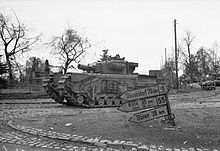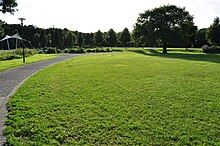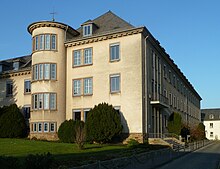Geilenkirchen
| coat of arms | Germany map | |
|---|---|---|
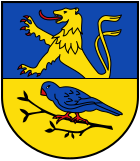
|
Coordinates: 50 ° 58 ' N , 6 ° 7' E |
|
| Basic data | ||
| State : | North Rhine-Westphalia | |
| Administrative region : | Cologne | |
| Circle : | Heinsberg | |
| Height : | 95 m above sea level NHN | |
| Area : | 83.2 km 2 | |
| Residents: | 27,470 (Dec. 31, 2019) | |
| Population density : | 330 inhabitants per km 2 | |
| Postal code : | 52511 | |
| Primaries : | 02451, 02453, 02462 | |
| License plate : | HS, ERK, GK | |
| Community key : | 05 3 70 012 | |
| LOCODE : | DE GKI | |
| City structure: | 30 districts, 13 urban districts | |
City administration address : |
Markt 9 52511 Geilenkirchen |
|
| Website : | ||
| Mayor : | Georg Schmitz (independent) | |
| Location of the city of Geilenkirchen in the Heinsberg district | ||
Geilenkirchen is a medium-sized district town in western North Rhine-Westphalia in the Heinsberg district ( Germany ).
geography
Geographical location
Geilenkirchen is about 20 km (as the crow flies ) north of Aachen , with the Teverener Heide , which belongs to the city area, directly on the Dutch border, on the southeast edge of the Selfkant , in the valley of the Wurm .
The city extends on both sides of the Wurm on the gently rising slopes of the Wurmtal, which rise from 70 m above sea level at river level to around 100 m.
Geilenkirchen extends over 9.5 km in a north-south direction and over 15.4 km east-west.
The three districts of Geilenkirchen, Bauchem (both left the Wurm) and Hünshoven (right the Wurm) have now completely grown together and form the core town of the municipality. The Wurm in the city center is built over a few hundred meters. The highest point in the municipality is at Gut Muthagen at 122.5 meters.
City structure and municipality area
According to the main statute , Geilenkirchen is divided into 30 localities, which are grouped into 13 districts and each represented by a local councilor.
- Beeck
- Geilenkirchen (core area) with Hünshoven and Bauchem
- Gillrath , Hatterath , Nierstrass and Panneschopp
- Grotenrath
- Immendorf , Waurichen and Apweiler
- Kraudorf , Nirm , Kogenbroich and Hoven
- Alleviate
- Niederheid
- Bumpers
- Süggerath
- Teveren and Bocket
- Tripsrath , Hochheid and Rischden
- Würm , Leiffarth , Flahstrasse , Müllendorf and Honsdorf
Neighboring communities
| Gangelt | Heinsberg | Hückelhoven |
| Brunssum (NL) |

|
Linnich |
| Landgraaf (NL) | Übach-Palenberg | Baesweiler |
geology
The city is located on a main terrace of the Geilenkirchen clay plate, in the natural area of the Lower Rhine lowlands .
climate
On July 24, 2019, at a Bundeswehr measuring station at the NATO airfield in Geilenkirchen, the highest air temperature measured in Germany to date was recorded at 40.5 ° C , at a height of 2 m and as a 1-hour average. The record only lasted for a short time, the next day higher temperatures were measured in several places in Germany, see the list of temperature records in Germany .
history
Geilenkirchen was on the left bank of its time meandering worm in an already in Roman times used ford . Grave finds from the 6th and 7th centuries - found in the 1930s in the "Kniepbusch" corridor - as well as individual early medieval fragments from an excavation on today's market square bear witness to the origins of the place in the early Middle Ages . The written tradition begins in 1170, when the Archbishop of Cologne Philip I von Heinsberg made donations to the collegiate church of St. Gangolf.
The medieval city was on the Roman road Aachen- Roermond , which crossed the Wurm here ; the ford was secured later and from the 12th century by a moated castle of the Counts of Heinsberg . After it was destroyed in 1945, the remains of this castle are now integrated into the Episcopal Gymnasium “St. Ursula ".
In 1798, at the time of the occupation of the Rhineland by Napoleon ( French period 1798–1814), Geilenkirchen was a canton in the Département de la Roer , in the Arrondissement d'Aix-la-Chapelle . It was Napoleon I who had the first documented stone bridge built over the Wurm when Geilenkirchen was under French rule.
In 1815, under Prussian rule, the Geilenkirchen district was established .
In 1918, after the First World War , the Rhineland was demilitarized and occupied by Allied troops ; In Geilenkirchen there were French, Moroccan and Belgian troops (Morocco had been a French protectorate since 1912 ). From 1918 to 1929, Belgian occupation soldiers were stationed in a barracks (Kamp van Dinant) that was built in the area of the Hünshoverner Hof.
In 1932 the district of Geilenkirchen was merged with the district of Heinsberg and the Selfkantkreis Geilenkirchen-Heinsberg was created with the city of Geilenkirchen as the district town.
During the Second World War , Geilenkirchen was part of the Siegfried Line . Its northern end was in Heinsberg (about 11 km north); In 1944 this line was extended in the direction of Venlo ( Maas-Rur position ). In November 1944 there was a head start ('Geilenkirchen Salient') along the front that protruded into the Allied front. On November 8, bombers threw napalm on Geilenkirchen. On November 10, 1944, Allied forces began an offensive called Operation Clipper to remove this ledge. On November 19, 1944, they occupied Geilenkirchen. The only 11 km away Heinsberg (more precisely: its ruins) was (s) in the course of the "hunger winter" only on 23/24. Captured January 1945.
After the war, Geilenkirchen was part of the British zone of occupation . In 1949 the Federal Republic of Germany was founded. The occupation, and thus the exercise of allied sovereignty, ended in West Germany in 1955 with the German Treaty .
In 1953, the Royal Air Force built an air base in the Teveren district on a field airfield that had already been used in the 1930s , which it used until 1968 and then handed it over to the Air Force (see Geilenkirchen Air Base ).
In 1971, during the municipal territorial reform through the Aachen Act , Geilenkirchen lost its status as a district town, as the Geilenkirchen-Heinsberg district and the Erkelenz district were merged to form the new Heinsberg district. The city of Heinsberg became the new district town. The tax office has since been housed in the former district building of the Selfkant district of Geilenkirchen-Heinsberg.
Place name
According to folk etymology , the name Geilenkirchen originally refers to a wooden church that a Franconian named Gelo built, for example in the sense of "Geilo's Church". Originally Geilenkirchen was called "Gelekircke" (local idiom also "Jellekercke"; in Dutch earlier "Geelkerken").
The name has been encountered since the last third of the 12th century in a wide variety of Lower Franconian and High German forms and mixed forms, depending on whether the writers of the documents were Low Franconian or High German: 1170 Joint Churches , 1244 Gelinkerike , 1252 Joint Church , 1270 Geilenkirge , 1276 Gelinkirke , 1277 Geilinkirchin , 1290 Gelinkirken , 1328 Gelynkirchen , 1363 Geillenkyrken etc.
In 1747 the city is indicated as a "Gedekirch" on a map of the "Catholic Netherlands and adjacent German provinces" ( Map - Pais Bas Catholiques - Belgium Catholicum ).
The dialect has retained the original Lower Franconian form in its “Gelekerke” to this day.
Incorporations
On January 1, 1972, the previously independent communities of Beeck, Immendorf, Lindern, Süggerath, Teveren and Würm were incorporated.
Population development
(as of December 31st)
| 2005 | 28,693 |
| 2010 | 28,253 |
| 2015 | 26,963 |
politics
According to the Law on Strengthening Local Democracy of April 9, 2013, the term of office of a mayor is five years.
mayor
- 1945–1954: Johannes Plum, CDU
- 1954–1958: Hubert Pennartz, CDU
- 1958–1961: Hans Schönauer, CDU
- 1961–1969: Rudolf Wyrsch, CDU
- 1969–1994: Heinrich Cryns, CDU
- 1994–2004: Franz Beemelmanns, CDU (full-time since 1999)
- 2004–2009: Andreas Borghorst, CDU
- 2009–2015: Thomas Fiedler , independent
- since 2015: Georg Schmitz , independent
City council
The city council consisted of 38 members in 2015
| Party / parliamentary group | Seats on the Council in 2015 |
|---|---|
| CDU | 15th |
| SPD | 4th |
| Alliance 90 / The Greens | 5 |
| free citizen list | 4th |
| left | 2 |
| non-party (drafted for NPD ) | 1 |
| non-party (drafted for SPD ) | 1 |
| for GK | 2 |
| Geilenkirchen move and FDP! | 4th |
(As of January 2020)
After the local elections in 2009, the city of Geilenkirchen was ruled by a four-party alliance made up of the SPD, FDP, Free Citizens' List and Alliance 90 / The Greens. Before this local election, the CDU ruled Geilenkirchen for 60 years with an absolute majority.
On September 29, 2010, the four-party alliance was terminated by the alliance parties after differences of opinion in connection with the redevelopment of the city center. Since then, political decisions have been made with varying majorities.
coat of arms
The city's coat of arms was derived from the city's oldest seal from 1556, which belonged to the Duke of Jülich (Wilhelm V). The origin of the bird ( parrot ) is probably a component that was taken from the coat of arms of 'Wilhelm von Jülich' (1556). The bird probably had its origin as a symbol of participation in the Crusades. The branch has no historical origin and was added in the 19th century.
The colors were changed in 1972. The current coat of arms in this form has existed since November 29, 1972.
Town twinning
Geilenkirchen has had a close partnership with the French city of Quimperlé in Brittany since 1966 . In addition, Geilenkirchen maintains good contacts with the Dutch cities near the border, especially with the city of Sittard-Geleen .
Culture and sights
Museums
- Selfkantbahn : The narrow-gauge railway of the Geilenkirchen district railway, formerly operated around 1900 from Alsdorf via Geilenkirchen (DB connection) to Wehr / Tüddern, is now operated as a museum railway on a 5.5 km long remainder from Geilenkirchen-Gillrath to Gangelt-Schierwaldenrath . It is the last steam-powered small train in North Rhine-Westphalia.
- Historical classroom in Immendorf: After the conversion of the secondary school in Immendorf to a primary school, a classroom was converted into a historical classroom in 1988. School utensils from the early to mid-20th century are exhibited there.
- House Basten
Institutions
- Cultural working group of the city of Geilenkirchen
Buildings
- in the Geilenkirchen district
- Church of St. Mary of the Assumption
- former Geilenkirchen Castle , today on the grounds of the Episcopal Gymnasium St. Ursula
- Jewish Cemetery
- Marienkapelle Stumpf: The Roman Catholic chapel is located on Rembrandtstrasse on private property, but is open to the public. The builders were the married couple Luise and Toni Stumpf. The chapel dedicated to Mary , the Mother of God , was designed by the Geilenkirchen architect Norbert Makarowski and was consecrated on April 28, 2012. Inside there is a bronze statue of the Virgin Mary , on the southeast side there is a window with stained glass .
- in the district of Hünshoven
- Church of St. Johann Baptist , built by Dominikus and Gottfried Böhm in 1950/51
- Evangelical Church , built 1865/66
- Evangelical rectory , formerly the home of the Camphausen family
- House Basten , formerly an oil mill
- in the valley of the worm
- Trips Castle , important water system (converted into an old people's home since 2004)
- Leerodt Castle
- Good Zumdahl
- between Hünshoven and Waurichen
- in the district of Bauchem
- Water tower (landmark) built in 1903, destroyed in 1944, rebuilt in 1947
- Church of St. Josef , built in 1974, demolished in 2018
- Dremmenshof (1790)
- Thorenshof (1660)
- in the district of Süggerath
- Church of the Holy Cross , built around 1560, the Antwerp reredos are worth seeing here
Park and nature reserve
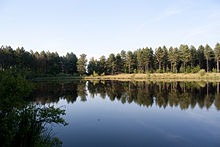
- Wurmauenpark
- Teverener Heide nature reserve
Economy and Infrastructure
traffic
Rail transport
Geilenkirchen has been connected to the Aachen – Mönchengladbach line since 1852 with the stations in Lindern ( category 4 station ) and Geilenkirchen ( also category 4 station ) .
Geilenkirchen station was an interregional stop for several years . Since the timetable change on December 15, 2013, the newly established weekday intercity train pair between Aachen and Berlin has also stopped in Geilenkirchen.
| line | Line designation | Line course | ||
|---|---|---|---|---|
| RE 4 | Wupper Express | Aachen Hbf - Herzogenrath - Geilenkirchen - Erkelenz - Rheydt Hbf - Mönchengladbach Hbf - Düsseldorf Hbf - Wuppertal Hbf - Hagen Hbf - Witten Hbf - Dortmund Hbf | ||
| RB 33 | Rhine-Niers Railway | Aachen Hbf - Herzogenrath - Geilenkirchen - Lindern ( wing ) | - Erkelenz - Rheydt Hbf - Mönchengladbach Hbf - Viersen - Krefeld Hbf - Duisburg Hbf | |
| - Heinsberg (Rheinl) | ||||
Bus transport
The city is also connected to the local public transport network of the Aachen Transport Association (AVV). The transport companies that are part of the transport association offer scheduled bus services between the most important cities and municipalities in the Aachen , Heinsberg and Düren districts in accordance with uniform tariff and transport conditions . A special feature of the "public transport offer" is the direct influence of the municipalities on the offer and a socially acceptable tariff structure. For Geilenkirchen and its rural surroundings, this is of particular importance for the extensive transport of students between homes and the centrally located so-called central schools .
In addition to the buses that operate according to the timetable on fixed lines, the multi-bus can also be requested.
Road traffic
The federal highway 46 begins / ends only a few kilometers northwest between Geilenkirchen and Heinsberg.
Geilenkirchen lies at the intersection of the federal road 221 (Aachen – Kleve) with the federal road 56 (Bonn – Sittard / NL).
Public facilities
The municipal institutions result from the municipal task structure within the framework of local self-administration. The legal basis is Article 78, Paragraph 3 of the state constitution of North Rhine-Westphalia.
- Town Hall, Markt 9
- City library, Martin-Heyden-Str. 24-26
- Indoor swimming pool
- Construction depot of the municipality
- Flahstrasse sewage treatment plant
- Police station
- Geilenkirchen volunteer fire brigade
- graveyards
- Sports fields
- Headquarters of the Kreissparkasse Heinsberg
- District Craftsmen
- Geilenkirchen tax office
schools
Various schools are located in Geilenkirchen:
- Episcopal Gymnasium St. Ursula (sponsor is the diocese of Aachen )
- Municipal secondary school
- Anita Lichtenstein Comprehensive School
- various elementary schools
- Vocational college economics (business high school)
- Vocational college for nutrition, social affairs and technology
- Music School Geilenkirchen e. V.
- Eichendorff-Kolleg Geilenkirchen (formerly the state institute for late-resettled high school graduates, since mid-2010 located in an extension at the Anita Lichtenstein Comprehensive School as Department IV)
- Janusz Korczak School (School for Educational Aid)
- St. Elisabeth Hospital Nursing School.
The Geilenkirchen campus of the FH Aachen , founded in 2009, accommodates up to 180 students from the Freshman Institute .
In addition, the Rheinische Fachhochschule Köln has been offering courses in business administration and business informatics on the CSB campus since 2015.
Energy supplier
The energy supply company Kreiswerke Heinsberg (KWH), which, after merging with the Kreisbahn Geilenkirchen and later with Kraftverkehr Erkelenz, also carried out public transport in the district as a transport company, had its headquarters and one of its two bus depots in the city. Efforts to rationalize the "public sector" led in 2003 to another merger of KWH with "Westdeutsche Licht & Kraft" (WLK) from Erkelenz to form WestEnergie und Verkehr GmbH . In 2015 the company was renamed WestVerkehr GmbH when the energy division was spun off in 2015. In the course of the outsourcing, the provision of supply and disposal services in the areas of energy, heat, water, sewage and waste will be carried out by WestEnergie GmbH. After the merger of NEW Niederrhein Energie und Wasser GmbH and WestEnergie GmbH , NEW takes over the implementation of the basic supply for the supply of natural gas and electrical energy.
Local transport company
The company WestVerkehr GmbH runs the regular and school traffic in the district of Heinsberg in public transport. The head office is in Geilenkirchen. The company's depots are in Geilenkirchen and Erkelenz.
Military facilities
Geilenkirchen is the location of two larger military facilities: the NATO Airbase in the Teveren district and the Selfkant barracks in the Niederheid district. For a long time, mobile missile systems ( Honest John , Pershing 1A , Sergeant , Lance and LARS ( light artillery missile system), a multiple rocket launcher 110 mm on a Magirus-Deutz self-propelled gun ) were stationed in both of them .
The air base and the barracks are of considerable economic importance for the structurally weak region, as they provide work for the military as well as numerous civilian employees and purchasing power that flows back into the region.
NATO airfield Geilenkirchen
The British Royal Air Force built and moved into an airfield in Teveren in 1953 , which it used until 1968. The facility was taken over by the German Air Force and is the location of the Pershing 1A short-range missile. In 1980 the missile squadron moved to the Selfkant barracks in Geilenkirchen and NATO moved into Teveren with the AWACS association, in which 16 NATO countries are actively involved in 2014. This association is therefore the only multinational association of NATO.
Geilenkirchen-Teveren are since 1982 on the Air Base Geilenkirchen the NATO - AWACS -Aufklärungsflugzeuge of type Boeing E-3 A Sentry stationed. Before the deployment, this led to considerable demonstrations by the peace movement , which wanted to make people aware that the AWACS aircraft could perform defensive and offensive tasks. Today, the legacy and long-outdated engines of the type Pratt & Whitney Jt3d (military designation Pratt & Whitney TF33) aircraft Source massive noise and emissions.
With around 2,400 jobs (including around 850 civilian employees) and an economic contribution of around 400 million euros, the Geilenkirchen NATO airfield is an important regional economic factor.
Selfkant barracks of the Bundeswehr

The Bundeswehr built the Selfkant barracks in Niederheid. In 1970 the rocket artillery training battalion 72 first moved into this as a training battalion ; In 1973 the army's missile school was relocated from Donnerberg barracks to Geilenkirchen. In the course of the relocation and merger with the training battalion, it was renamed the rocket school of the artillery . After restructuring and moving out of the rocket artillery from 1981, Missile Squadron 2 (FKG2) was in the Selfkant barracks until it was disbanded in 1991. The ZVBw (Center for Verification Tasks of the Bundeswehr) has been stationed there since 1991 .
RakArtLBtl 72 training battalion , 1970–1981 Geilenkirchen
Missile Squadron 2, 1968–1981 Teveren airfield, 1981–1991 Selfkant barracks
media
Local press
- Geilenkirchen city gazette
Companies
A number of nationally and internationally active commercial enterprises are based in Geilenkirchen. The six largest companies in terms of number of employees (all employing over 200 people) are:
| Company / institution | Employees |
|---|---|
| CSB-System AG | 600 |
| KSK Industrielackierung GmbH & Co. KG | 350 |
| St. Elisabeth Hospital Geilenkirchen gGmbH | 680 |
| Wilhelm Jansen Eisenjansen GmbH & Co. KG | 235 |
| ZenTec automotive GmbH | 210 |
| SpanSet-secutex GmbH |
Personalities
Honorary citizen
- Albert Jansen (1903–1974), businessman
Born in Geilenkirchen
- Alina Bock (* 1984), singer in the band beFour
- Marlon Bröhr (* 1974), politician (CDU), district administrator of the Rhein-Hunsrück district
- Ludolf Camphausen (1803–1890), banker, Prussian Prime Minister in the revolutionary year of 1848
- Otto von Camphausen (1812–1896), Prussian Finance Minister
- Hermann Corsten (1889–1968), librarian
- Leo Dautzenberg (* 1950), politician (CDU), member of the German Bundestag from 1998 to 2011
- Christoph Dohmen (* 1957), Professor of the Old Testament at the University of Regensburg
- Elmar Fischer (* 1968), director
- Lambert von Fisenne (1852–1903), architect and author
- Anja Fröhlich (* 1964), writer, author of books for young people and children
- Arthur von Goltstein (1813–1882), politician, member of the Prussian manor house
- Helmut Halfmann (* 1950), ancient historian
- Jürgen Heinrichs (* 1977), football player
- Hans Horrichs (1900–1987), local politician, electoral officer and president of the German Association of Cities
- Albert Jansen (1903–1974), businessman, association politician and founder
- Manfred Jansen (* 1956), soccer player
- Bernhard Jussen (* 1959), historian
- Detmar Kurig (* 1966), double bass player and university professor
- Christoph Leisten (* 1960), writer
- Horst Matzerath (* 1937), historian
- Wilfried Mohren (* 1958), former sports reporter
- Franz Joseph Nuß (1775–1842), lawyer and temporarily acting mayor of the city of Mülheim am Rhein
- Lothar Romain (1944–2005), journalist and art scholar
- Sabine Schiffer (* 1966), linguist and media educator
- Hans Peter Schmitz (* 1937), farmer and politician (CDU), member of the German Bundestag from 1972 to 2002
- Georg Schmitz (* 1950), mayor
- Gerd Sonntag (* 1962), writer
- Jürgen Tarrach (* 1960), film actor
- Max Wilms (1867–1918), doctor and surgeon
Connected to the city

- Nikolaus Becker (1809–1845), clerk at the magistrate's court and writer; Poet of the Rhine song
- Jenny Böken (1989–2008), medical officer candidate for the German Navy, grew up in Geilenkirchen and is buried there
- Matthias Küsters (* 1946), former headmaster of the Episcopal Gymnasium St. Ursula, publisher of the journal Religion Matters Us
- Anne Marie Stoll-Rommerskirchen (1909–1985) painter and sculptor, spent the last years of her life in Geilenkirchen
- Heinrich Meuffels (1927–2015), politician; 1956–1967 and 1984–1994 member of the city council
- Konrad Volm (1897–1958), politician (NSDAP)
- Willi Arlt (artist) (* 1954), sculptor (metal), lives and works in Geilenkirchen-Lindern
literature
- Hermann Wassen: The seven-armed candlestick - The history of the Geilenkirchen Jews . In: Local calendar of the Heinsberg district . Year 1985, pp. 163–178.
- Hans-Josef Sprünken: The medieval college of aldermen in Geilenkirchen . In: Local calendar of the Heinsberg district . Year 1991, pp. 133–147.
- Harry Seipolt: I was "inferior" . From the life report of a NS-compulsorily sterilized person (NS-Rassenwahn in the "Erbgesundheitsgericht" and health department of the city of Geilenkirchen). In: History in the West. Half-yearly journal for regional and contemporary history (Volume 8, Issue 2), Cologne 1993, pp. 193–200.
- Hans-Josef Sprünken: 130 years of the Ursuline children's institution in Geilenkirchen . In: Local calendar of the Heinsberg district . Year 1996, pp. 43–57.
- Alt-Geilenkirchen and its neighbors . Historical illustrated book from and around Geilenkirchen. Fred Gatzen Verlag, Geilenkirchen 1986, ISBN 3-923219-06-7 .
- Walter Scheufen: Geilenkirchen and its village communities . Stadt-Bild-Verlag, Leipzig 2007, ISBN 978-3-937126-51-7 .
- The fight for Geilenkirchen, Helios Verlag, ISBN 978-3-86933-223-9 , published: October 9, 2018
Web links
- Link catalog on Geilenkirchen at curlie.org (formerly DMOZ )
- Monuments in the city of Geilenkirchen
- Churches and chapels in the city of Geilenkirchen
Individual evidence
- ↑ Population of the municipalities of North Rhine-Westphalia on December 31, 2019 - update of the population based on the census of May 9, 2011. State Office for Information and Technology North Rhine-Westphalia (IT.NRW), accessed on June 17, 2020 . ( Help on this )
- ↑ http://www.tim-online.nrw.de/
- ^ Main statute of the city of Geilenkirchen. (PDF; 31 kB) (No longer available online.) City of Geilenkirchen, December 10, 2015, archived from the original on June 9, 2016 ; accessed on December 10, 2015 (§ 3 division of the urban area into districts). Info: The archive link was inserted automatically and has not yet been checked. Please check the original and archive link according to the instructions and then remove this notice.
- ↑ 40.5 degrees is a new German record. tagesschau.de, accessed on July 24, 2019 .
- ↑ https://www.tagesspiegel.de/gesellschaft/panorama/40-5-grad-in-geilenkirchen-bundeswehr-misst-neuen-deutschen-hitzerekord/24697526.html
- ↑ Now even 42 degrees - German heat record in Emsland. Spiegel Online, July 25, 2019, accessed on the same day.
- ^ Frank Siegmund: Merovingian time on the Lower Rhine. Rhenish excavations 34. Rheinland-Verlag, Cologne 1998, pp. 296–299
- ^ Theodor Josef Lacomblet: Document book for the history of the Lower Rhine. Düsseldorf 1840-1858, Volume I, p. 305 no. 436
- ↑ http://www.history.army.mil/books/wwii/Siegfried/Siegfried%20Line/siegfried-ch23.htm page 547
- ↑ There is no reliable scientific evidence for this interpretation.
- ↑ Maurits Gysseling: Toponymisch Woordenboek vam Belgie, Netherlands, Luxembourg, Noord-Frankrijk en West-Duitsland. without location 1960, p. 391.
- ^ Federal Statistical Office (ed.): Historical municipality directory for the Federal Republic of Germany. Name, border and key number changes in municipalities, counties and administrative districts from May 27, 1970 to December 31, 1982 . W. Kohlhammer, Stuttgart / Mainz 1983, ISBN 3-17-003263-1 , p. 310 .
- ^ Geilenkirchen: twin town
- ↑ Historical classroom on web-toolbox.de. (No longer available online.) Archived from the original on August 6, 2013 ; Retrieved July 7, 2013 . Info: The archive link was inserted automatically and has not yet been checked. Please check the original and archive link according to the instructions and then remove this notice.
- ↑ Historical classroom on info-immendorf.de. Retrieved July 7, 2013 .
- ^ Website of the Marienkapelle Stumpf - accessed on July 22, 2014
- ↑ http://www.west-verkehr.de/images/pdf/west_multibus_karte.pdf Multibus operation in the Heinsberg district
- ↑ Business High School. Retrieved December 17, 2016 .
- ↑ Studying at the CSB-Campus - Registration and application for a place are now possible. Retrieved June 8, 2015 .
- ^ Studying in Geilenkirchen. Retrieved June 8, 2015 .
- ↑ Archive link ( Memento of the original from March 4, 2016 in the Internet Archive ) Info: The archive link was inserted automatically and has not yet been checked. Please check the original and archive link according to the instructions and then remove this notice. WestEnergie GmbH 2015
- ↑ The future of WestEnergie
- ↑ https://www.new-energie.de/veroeffnahmungen/westenergie-gmbh ( page no longer available , search in web archives ) Info: The link was automatically marked as defective. Please check the link according to the instructions and then remove this notice. Customer information, publication of NEW Energie from June 14, 2017
- ↑ http://www.az-web.de/news/topnews-detail-az/1431579/Geilenkirchen-behaelt-seine-Nato-Airbase
- ↑ Geilenkirchen city gazette
- ↑ Archived copy ( memento of the original dated December 6, 2016 in the Internet Archive ) Info: The archive link was inserted automatically and has not yet been checked. Please check the original and archive link according to the instructions and then remove this notice.
- ↑ New multi-storey car park: the trucks will roll in from Tuesday. Aachener Zeitung online, April 14, 2017, accessed on April 14, 2017 .
- ↑ http://www.zentec-automotive.de/?structure=content&cat_id=13
- ↑ Archive link ( Memento of the original from June 5, 2011 in the Internet Archive ) Info: The archive link was inserted automatically and has not yet been checked. Please check the original and archive link according to the instructions and then remove this notice.








